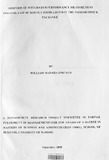| dc.description.abstract | The objective of performance measurement has changed over the past few decades. Traditional performance measures based on productivity are no longer appropriate or representative of the information needs of today’s competitive global market. Alternative performance measurement systems have been proposed that range from time as the basis of all measures to the integration of a variety of performance measures. This research paper reviews and analyses the limitations of traditional approaches to performance measurement as well as the emerging trends in performance measurement systems development. It dwells on integrated performance measurement systems as a tool to ensure that organizations remain profitable and competitive in the ever changing business environment. The research further attempts to determine the level to which service organizations listed in the Nairobi Stock Exchange have adopted the use of integrated performance measurement systems.
The service sector is going through a period of major changes in which established ways of doing business continue to be shunted or put aside. During the last decades, service organizations have been undergoing considerable transformations at macro and micro levels, mainly due to the globalization, enhanced business applications of technological advances as well as the requirements and implications of the knowledge and experience-based economy. As a result, customers are becoming less loyal, more price sensitive and discerning. The onus is on the managers of service firms to ensure that they anticipate the changes, and adapt to change while maintaining high levels of service delivery at competitive prices. Integrated performance measurement systems provide a key plank for capturing information on all the dimensions of a business.
Publicly listed companies have an even greater challenge than those which are not. There are numerous legal requirements which are meant to ensure that the public’s (shareholder’s) stock is managed in the most professional way possible. Their directors and managers have significant interest in improving corporate governance since they represent many stockholders, and their actions are required to be transparent to the public and to the financial community. They face constant competition from private organizations and government-owned parastatals and as such, have to strive to ensure that they provide their customers with quality service to remain profitable. Service sector organizations thus have to continuously learn and improve in order to retain and even expand their market share.
The research reveals that there is a moderate level of application of integrated performance measurement systems amongst the service organizations listed in the NSE. Integrated performance measurement systems consist of a family of measures with many components. There are thus some components which are significantly applied, while others have low application rates. The service organizations are listed in different sectors of the NSE, and there isn’t much variation in the extent of application of the modern measures amongst the different sectors. The study also revealed that there is a low level of involvement of external stakeholders during the setting up and management of performance measures by the companies.
The main challenge faced in the development and management of the measures was the attitude towards the exercise. Others included lack of management support, time taken for training and implementation of a new performance measurement system and lack of employee support. Unclear reward system was also mentioned as a setback in getting employees to embrace the application of integrated performance measurement systems in their respective organizations.
The researcher recommended that the companies should strive to improve on the components of integrated performance measurement systems which were poorly applied. It is only then that full benefits can accrue, whereby management gets a full multi-dimensional status of an organization and initiate any intervention measures where necessary before it’s too late.
The major limitation of the study was the reluctance to provide information on performance measurement by many companies. Many other respondents also felt that the information required was sensitive, and as such required official authorization. The study also only covered service organizations. There is need to study other sectors, e.g. manufacturing or a study of all the firms listed in the NSE to get a complete picture of the level to which integrated performance measurement systems are applied. | en |

